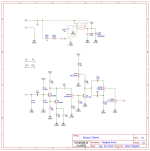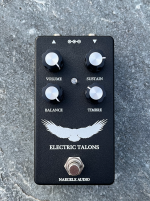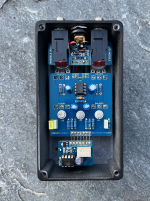PedalBuilder
Well-known member
Not my most recent build (I built it last January, so it's one of my older builds), but a very enjoyable one. For those not in the know, the Buzzaround (PedalPCB Gnat) is a wonderfully nasty germanium fuzz. Garage rock? Psychedelia? Death metal? Sure, the Buzzaround can handle all of those and more. Here's the schematic that I used:

Two germanium transistors in a Darlington configuration serve as the input stage, which distorts slightly and then slams the clipping stage. The clipping stage uses a single leaky germanium transistor, which is biased via the leakage of a germanium diode. (More on this later.) The clipping stage then goes into a rudimentary but effective tone stack. If you're thinking, this sounds like the Tone Bender Mk. III or Mk. IV, you would be correct. Someone at Sola Sound/Macaris came across a Buzzaround some time in 1966 or 1967, liked what they heard, and used it as the starting point for the Tone Bender Mk. III.
I departed from the original in a few key respects. First, I added a volume control at the output. The original used the Balance control as the volume control. As you may notice, it's not a traditional volume control, and while it does function as a volume control, it also changes the bias of Q3 as it's adjusted. Adding a volume control gives you a bit more tonal versatility. Second, I borrowed a mod from David Main, and re-tuned the tone stack by increasing C4 from 100nF to 220nF and increasing R10 from 10k to 33k. This shifts the high pass filter in the tone stack down to a more useable range and increases the output level.
Outside

Inside

The transistors are tiny flying saucer-type Soviet germanium from the mid- to late-70s—GT309B for Q1 (hFE 81, leakage 13µA) and Q2 (hFE 86, leakage 14µA), and GT115D for Q3 (hFE 167, leakage 311µA). The diode is a D9E. After spending quite a lot of time playing around with the Buzzaround, Dizzy Tone, and Tone Bender Mk. III, my biggest takeaway is that it's worth spending at least as much time selecting the diode as it is selecting the transistors. Leakier diodes like the D9 family generally mean a more gated fuzz, while progressively less leaky diodes like the D312, D310, and D18 produce a smoother fuzz (with a higher noise floor). The D9E that I used gives the fuzz a nice gating effect, cutting the noise when I'm not playing without cutting off the tails of notes or introducing weird artifacts.
The pedal name is a nod to Valley of the Sun's excellent album Electric Talons of the Thunderhawk:

Two germanium transistors in a Darlington configuration serve as the input stage, which distorts slightly and then slams the clipping stage. The clipping stage uses a single leaky germanium transistor, which is biased via the leakage of a germanium diode. (More on this later.) The clipping stage then goes into a rudimentary but effective tone stack. If you're thinking, this sounds like the Tone Bender Mk. III or Mk. IV, you would be correct. Someone at Sola Sound/Macaris came across a Buzzaround some time in 1966 or 1967, liked what they heard, and used it as the starting point for the Tone Bender Mk. III.
I departed from the original in a few key respects. First, I added a volume control at the output. The original used the Balance control as the volume control. As you may notice, it's not a traditional volume control, and while it does function as a volume control, it also changes the bias of Q3 as it's adjusted. Adding a volume control gives you a bit more tonal versatility. Second, I borrowed a mod from David Main, and re-tuned the tone stack by increasing C4 from 100nF to 220nF and increasing R10 from 10k to 33k. This shifts the high pass filter in the tone stack down to a more useable range and increases the output level.
Outside

Inside

The transistors are tiny flying saucer-type Soviet germanium from the mid- to late-70s—GT309B for Q1 (hFE 81, leakage 13µA) and Q2 (hFE 86, leakage 14µA), and GT115D for Q3 (hFE 167, leakage 311µA). The diode is a D9E. After spending quite a lot of time playing around with the Buzzaround, Dizzy Tone, and Tone Bender Mk. III, my biggest takeaway is that it's worth spending at least as much time selecting the diode as it is selecting the transistors. Leakier diodes like the D9 family generally mean a more gated fuzz, while progressively less leaky diodes like the D312, D310, and D18 produce a smoother fuzz (with a higher noise floor). The D9E that I used gives the fuzz a nice gating effect, cutting the noise when I'm not playing without cutting off the tails of notes or introducing weird artifacts.
The pedal name is a nod to Valley of the Sun's excellent album Electric Talons of the Thunderhawk:

